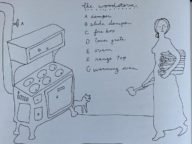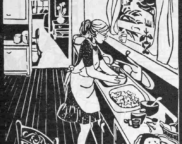The Countercultural Kitchen
* * *
Living through a pandemic has turned many lives upside-down. Some people are deemed essential employees and continue to work under stressful circumstances, while others are out of a job and confined to their homes. News of food shortages and purchase limits has caused many to consider alternative modes of acquiring food.
As self-isolation became the norm, I began to notice an interesting trend: Given the topsy-turvy, confusing, and uncertain state of the world, many people turned to making bread and planting gardens both as a source of food and a distraction. This return to the earth, return to the kitchen, and return to the basics of food preparation reminded me of the introduction of the 1970s cookbook, Laurel’s Kitchen. Carol Flinders, the author of the introduction, describes how her disillusionment with society and mainstream food sources inspired her to find the joy and release of natural foods and cooking. I felt that this paralleled the sudden increase in people making bread; when things are not going to plan, we return to food as a comfort.
This is what inspired me to explore the countercultural kitchen. What did it look like to cook and eat outside of the mainstream? How did different people embrace the ideals of the countercultural kitchen? What legacies did the countercultural food movement leave? These are all questions I explored when creating this video as a way to find where the joy of kneading bread and growing carrots comes from and why.
— Emily Lempko, May 2020
Emily Lempko (Cal ’20) is a recent graduate with a Bachelor’s degree in History and a certificate in Global Urban Humanities.
***
Video Transcript
“This is the image of the stereotypical 1950s kitchen. The wife in the kitchen preparing meals while her husband and children eagerly await. These images are seen everywhere, from advertisements, to movies, to cookbooks. The message within these is clear: This was the ideal American home.
However, the way Americans think about food and make food doesn’t quite look like this anymore. While canned foods and boxed cake mixes are still a favorite time-saver in the kitchen, there is also a great deal of emphasis on organic produce, meatless diets, and for some, growing your own food. Where did this mindset come from?
These ideas grew out of the 1970s in the counterculture food movement, or sometimes known as the ‘slow food movement’. This movement shared some of the same ideas of hippies and revolutionaries of the time: self sufficiency and self reliance outside of the market and outside of the mainstream. It also emphasized the importance of recognizing where one’s food came from, appreciating naturally grown foods, and learning to love raw, unprocessed meals. These ideals are represented in Alice Waters’ series Thirty Recipes Suitable for Framing. In this series, Waters incorporates the ideals of the counterculture movement by framing recipes around the natural, raw state of the ingredient. Along with artist David Goines, Waters depicts the beauty of returning to the source, and appreciating what the Earth has to offer.
The counterculture food movement did not look the same for everyone. For some, the movement looked like this: living away from society, growing one’s own food, and connecting with the land and where one’s food comes from. These images are from the Wheeler’s Ranch commune of the late 1960s and early 1970s. Wheeler’s Ranch was a popular spot for the counterculture food movement, housing one of the movement’s most prominent actors: writer and artist Alicia Bay Laurel.
Laurel moved to Wheeler’s Ranch when she was 19 years old, and used the knowledge she gained from living there to write Living on the Earth. This was no ordinary cookbook; it was fully illustrated, depicting the cookbook’s dedication to sourcing one’s food from the Earth and how to be self-sustaining. This image from another one of Laurel’s books illustrates how she imagined the counterculture kitchen; the father, in the kitchen making bread from scratch; the woman, outside tending to the bees; and the daughter, though young, helping to create dishware. This image emphasizes three important tenets of how Laurel envisioned the counterculture kitchen: the involvement of the entire family in the food-making process, an emphasis on sourcing one’s food directly from the earth, and self-sufficiency.
Interestingly enough, Laurel’s countercultural, against-the-grain cookbook became wildly popular amongst mainstream home cooks. It sold hundreds of thousands of copies, and even made its way to the New York Times bestseller list. This represents a bridge to another side of the counterculture food movement.
Not everyone who participated in this movement resided in communes. Many lived in suburban neighborhoods, worked normal jobs, and maintained a household that looked similar to the rest of 1970s society. However, their distinction from the mainstream was rooted in the same idea: becoming as self-sustaining as possible, sourcing one’s food responsibly, and incorporating the entire family in the process.
The inspiration for this came from popular cookbooks based in the counterculture, similar to Living on the Earth. These are cookbooks like the Moosewood Cookbook or Laurel’s Kitchen. These cookbooks pushed for a new way of sourcing and preparing meals, emphasizing nutrition, responsibility, and even artistry.
In an excerpt from Laurel’s Kitchen, the narrator reads, ‘I threw myself heart and soul into breadmaking in the days that followed. Baking just two to four loaves seemed a light task after helping to turn out twelve at one blow. My mood picked up even faster when I discovered what a wide margin for error there actually was in the process. I began to understand Laurel’s fondness for the redoubtable yeasties. They could take a lot of knocking around, and they seemed willing to extend themselves generously in deference to my ineptitude.’ Here, the narrator is describing how she came to understand the joy of participating in the food making process, as well as the beauty in it. The sense of independence, though frightening to the author, is what the counterculture food movement aimed for: the ability to rely on nobody but oneself for their food.
Even though the counterculture food movement did not last beyond the 1970s, its efforts have not gone unnoticed. The counterculture movement inspired many to try vegetarianism and veganism, grocery stores emphasize organic produce, companies have changed recipes to be more natural, and fair trade products have become mainstream. Because of the counterculture food movement, consumers today are much more mindful of where their food comes from, what they are putting in their bodies, and the joy of cooking a meal from scratch.”
“It's easy to fall into despair, overwhelmed at the picture of Yankee know-how run amok, chomping up mountains and rivers to produce Barbie Dolls and Screaming Yellow Zonkers. But before you crumple up in a heap, notice the critical link in this awesome chain of industrialism. The reason for overconsumption is overconsumers.”
— Carol Flinders, Laurel's Kitchen (1976)

